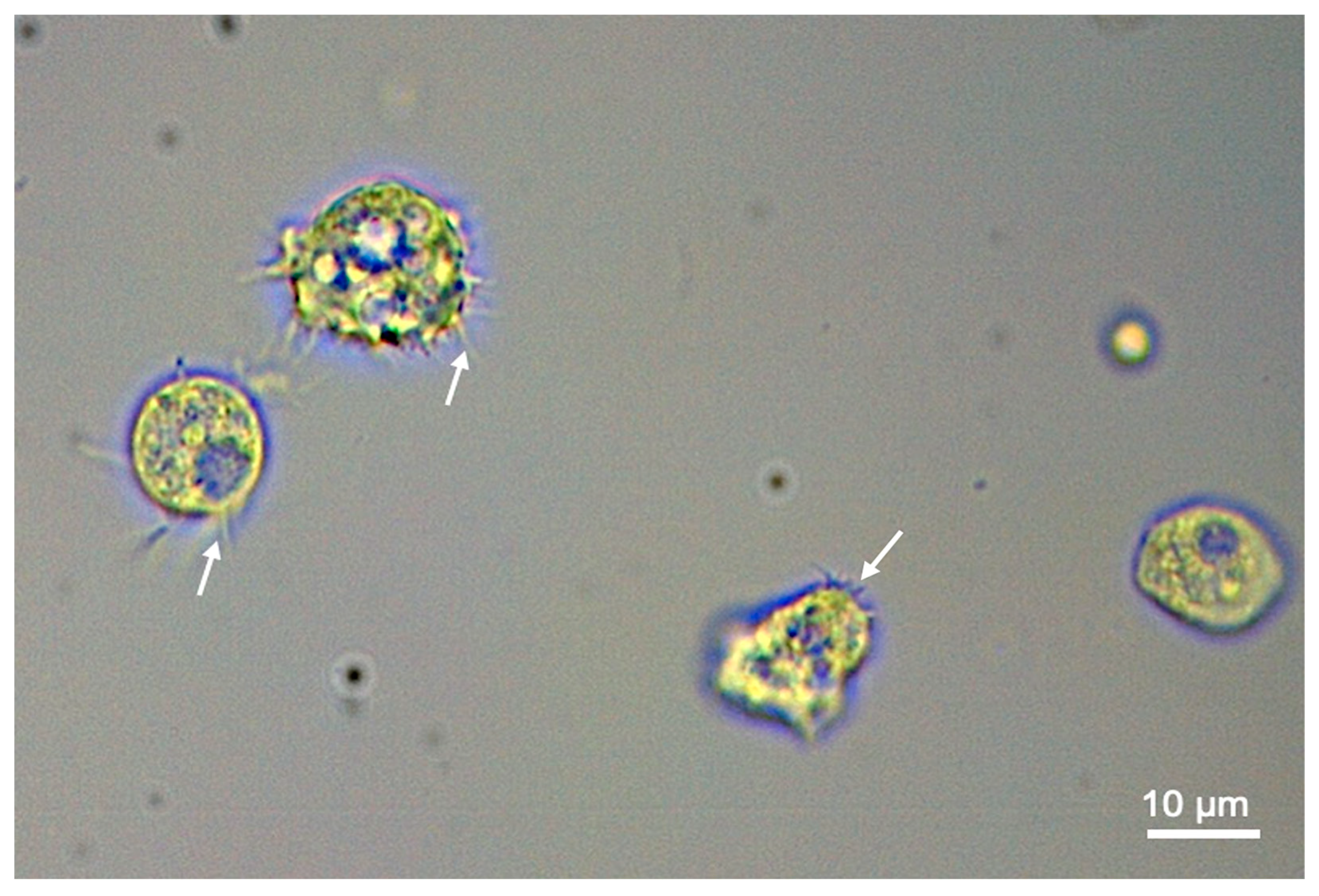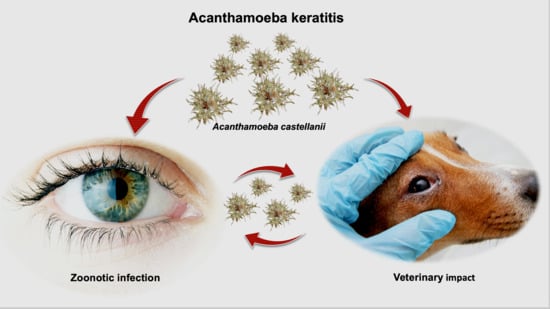Should Veterinary Practitioners Be Concerned about Acanthamoeba Keratitis?
Abstract
:1. Introduction
2. Can Animals Be Affected by AK?
3. Clinical Signs
4. Available Diagnostics
5. Treatment Options
6. Unconventional Treatment Options
7. Conclusions
Author Contributions
Funding
Institutional Review Board Statement
Informed Consent Statement
Data Availability Statement
Conflicts of Interest
References
- Elsheikha, H.M.; Siddiqui, R.; Khan, N.A. Drug discovery against Acanthamoeba infections: Present knowledge and unmet needs. Pathogens 2020, 9, 405. [Google Scholar] [CrossRef] [PubMed]
- Lorenzo-Morales, J.; Khan, N.A.; Walochnik, J. An update on Acanthamoeba keratitis: Diagnosis, pathogenesis and treatment. Parasite 2015, 22, 10. [Google Scholar] [CrossRef] [Green Version]
- Brindley, N.; Matin, A.; Khan, N.A. Acanthamoeba castellanii: High antibody prevalence in racially and ethnically diverse populations. Exp. Parasitol. 2009, 121, 254. [Google Scholar] [CrossRef]
- Moore, M.B. Acanthamoeba keratitis and contact lens wear: The patient is at fault. Cornea 1990, 9, S33–S35. [Google Scholar] [CrossRef]
- Schuster, F.L.; Visvesvara, G.S. Free-living amoebae as opportunistic and non-opportunistic pathogens of humans and animals. Int. J. Parasitol. 2004, 34, 1001–1027. [Google Scholar] [CrossRef]
- Dyková, I.; Lom, J.; Schroeder-Diedrich, J.M.; Booton, G.C.; Byers, T.J. Acanthamoeba strains isolated from organs of freshwater fishes. J. Parasitol. 1999, 85, 1106–1113. [Google Scholar] [CrossRef] [PubMed] [Green Version]
- Sesma, M.J.M.; Ramos, L.Z. Isolation of free-living amoebas from the intestinal contents of reptiles. J. Parasitol. 1989, 75, 322–324. [Google Scholar] [CrossRef]
- Walochnik, J.; Hassl, A.; Simon, K.; Benyr, G.; Aspöck, H. Isolation and identification by partial sequencing of the 18S ribosomal gene of free-living amoebae from necrotic tissue of Basiliscus plumifrons (Sauria: Iguanidae). Parasitol. Res. 1999, 85, 601–603. [Google Scholar] [CrossRef] [PubMed]
- Culbertson, C.G. The pathogenicity of soil amebas. Annu. Rev. Microbiol. 1971, 25, 231–254. [Google Scholar] [CrossRef]
- Feng, X.; Zheng, W.; Wang, Y.; Zhao, D.; Jiang, X.; Lv, S. A rabbit model of Acanthamoeba Keratitis that better reflects the natural human infection. Anat. Rec. 2015, 298, 1509–1517. [Google Scholar] [CrossRef] [PubMed] [Green Version]
- He, Y.G.; McCulley, J.P.; Alizadeh, H.; Pidherney, M.; Mellon, J.; Ubelaker, J.E.; Stewart, G.L.; Silvany, R.E.; Niederkorn, J.Y. A pig model of Acanthamoeba keratitis: Transmission via contaminated contact lenses. Investig. Ophthalmol. Vis. Sci. 1992, 33, 126–133. [Google Scholar]
- Visvesvara, G.S.; Moura, H.; Schuster, F.L. Pathogenic and opportunistic free-living amoebae: Acanthamoeba spp., Balamuthia mandrillaris, Naegleria fowleri, and Sappinia diploidea. FEMS Immunol. Med. Microbiol. 2007, 50, 1–26. [Google Scholar]
- Schuster, F.L.; Visvesvara, G.S. Opportunistic amoebae: Challenges in prophylaxis and treatment. Drug Resist. Updat. 2004, 7, 41–51. [Google Scholar] [CrossRef] [PubMed]
- Niederkorn, J.Y.; Ubelaker, J.E.; McCulley, J.P.; Stewart, G.L.; Meyer, D.R.; Mellon, J.A.; Silvany, R.E.; He, Y.G.; Pidherney, M.; Martin, J.H. Susceptibility of corneas from various animal species to in vitro binding and invasion by Acanthamoeba castellanii [corrected]. Investig. Ophthalmol. Vis. Sci. 1992, 33, 104. [Google Scholar]
- Montoya, A.; Miró, G.; Saugar, J.M.; Fernández, B.; Checa, R.; Gálvez, R.; Bailo, B.; Marino, V.; Piñero, J.E.; Lorenzo-Morales, J.; et al. Detection and molecular characterization of Acanthamoeba spp. in stray cats from Madrid, Spain. Exp. Parasitol. 2018, 188, 8–12. [Google Scholar] [CrossRef]
- Richter, M.; Matheis, F.; Gönczi, E.; Aeby, S.; Spiess, B.M.; Greub, G. Parachlamydia acanthamoebae in domestic cats with and without corneal disease. Vet. Ophthalmol. 2010, 13, 235–237. [Google Scholar] [CrossRef] [Green Version]
- Ithoi, I.; Mahmud, R.; Abdul Basher, M.H.; Jali, A.; Abdulsalam, A.M.; Ibrahim, J.; Mak, J.W. Acanthamoeba genotype T4 detected in naturally-infected feline corneas found to be in homology with those causing human keratitis. Trop. Biomed. 2013, 30, 131–140. [Google Scholar] [PubMed]
- Karakuş, M.; Aykur, M.; Özbel, Y.; Töz, S.; Dağcı, H. Molecular detection and genotyping of Acanthamoeba spp. among stray dogs using conjunctival swab sampling. Acta Tropica 2016, 164, 23–26. [Google Scholar] [CrossRef]
- Karakavuk, M.; Aykur, M.; Şahar, E.A.; Karakuş, M.; Aldemir, D.; Döndüren, Ö.; Özdemir, H.G.; Can, H.; Gürüz, A.Y.; Dağcı, H.; et al. First time identification of Acanthamoeba genotypes in the cornea samples of wild birds; Is Acanthamoeba keratitis making the predatory birds a target? Exp. Parasitol. 2017, 183, 137–142. [Google Scholar] [CrossRef]
- Valladares, M.; Reyes-Batlle, M.; Martín-Navarro, C.M.; López-Arencibia, A.; Dorta-Gorrín, A.; Wagner, C.; Martínez-Carretero, E.; Piñero, J.E.; Valladares, B.; Lorenzo-Morales, J. Molecular characterization of Acanthamoeba strains isolated from domestic dogs in Tenerife, Canary Islands, Spain. Arch. Microbiol. 2015, 197, 639–643. [Google Scholar] [CrossRef] [PubMed]
- Brofman, P.J.; Knostman, K.A.; DiBartola, S.P. Granulomatous amebic meningoencephalitis causing the syndrome of inappropriate secretion of antidiuretic hormone in a dog. J. Vet. Intern. Med. 2003, 17, 230–234. [Google Scholar] [CrossRef] [PubMed]
- Dubey, J.P.; Benson, J.E.; Blakeley, K.T.; Booton, G.C.; Visvesvara, G.S. Disseminated Acanthamoeba sp. infection in a dog. Vet. Parasitol. 2005, 128, 183–187. [Google Scholar] [CrossRef] [PubMed]
- Valladares, M.; Reyes-Batlle, M.; Mora-Peces, I.; Martín-Navarro, C.M.; López-Arencibia, A.; Dorta-Gorrín, A.; Comyn-Afonso, E.; Martínez-Carretero, E.; Maciver, S.K.; Piñero, J.E.; et al. A multisystemic Acanthamoeba infection in a dog in Tenerife, Canary Islands, Spain. Vet. Parasitol. 2014, 205, 707–711. [Google Scholar] [CrossRef] [PubMed]
- Leher, H.; Silvany, R.; Alizadeh, H.; Huang, J.; Niederkorn, J.Y. Mannose induces the release of cytopathic factors from Acanthamoeba castellanii. Infect. Immun. 1998, 66, 5–10. [Google Scholar] [CrossRef] [Green Version]
- Fydryszewski, N.A.; Hanna, P.H. Acanthamoeba keratitis--a diagnostic challenge. Clin. Lab. Sci. 2011, 24, 202–207. [Google Scholar] [CrossRef] [PubMed]
- Randag, A.C.; van Rooij, J.; van Goor, A.T.; Verkerk, S.; Wisse, R.P.L.; Saelens, I.E.Y.; Stoutenbeek, R.; van Dooren, B.T.H.; Chengm, Y.Y.Y.; Eggink, C.A. The rising incidence of Acanthamoeba keratitis: A 7-year nationwide survey and clinical assessment of risk factors and functional outcomes. PLoS ONE 2019, 14, e0222092. [Google Scholar] [CrossRef]
- Maubon, D.; Dubosson, M.; Chiquet, C.; Yera, H.; Brenier-Pinchart, M.P.; Cornet, M.; Savy, O.; Renard, E.; Pelloux, H. A one-step multiplex PCR for acanthamoeba keratitis diagnosis and quality samples control. Investig. Ophthalmol. Vis. Sci. 2012, 53, 2866–2872. [Google Scholar] [CrossRef] [Green Version]
- Radford, C.F.; Minassian, D.C.; Dart, J.K. Acanthamoeba keratitis in England and Wales: Incidence, outcome, and risk factors. Br. J. Ophthalmol. 2002, 86, 536. [Google Scholar] [CrossRef] [Green Version]
- Alexander, C.L.; Coyne, M.; Jones, B.; Anijeet, D. Acanthamoeba keratitis: Improving the Scottish diagnostic service for the rapid molecular detection of Acanthamoeba species. J. Med. Microbiol. 2015, 64, 682. [Google Scholar] [CrossRef] [Green Version]
- Khairnar, K.; Tamber, G.S.; Ralevski, F.; Pillai, D.R. Comparison of molecular diagnostic methods for the detection of Acanthamoeba spp. from clinical specimens submitted for keratitis. Diagn. Microbiol. Infect. Dis. 2011, 70, 499–506. [Google Scholar] [CrossRef]
- Lim, N.; Goh, D.; Bunce, C.; Xing, W.; Fraenkel, G.; Poole, T.R.; Ficker, L. Comparison of polyhexamethylene biguanide and chlorhexidine as monotherapy agents in the treatment of Acanthamoeba Keratitis. Am. J. Ophthalmol. 2008, 145, 130–135. [Google Scholar] [CrossRef] [PubMed]
- McClellan, K.; Howard, K.; Niederkorn, J.Y.; Alizadeh, H. Effect of steroids on Acanthamoeba cysts and trophozoites. Investig. Ophthalmol. Vis. Sci. 2001, 42, 2885–2893. [Google Scholar]
- Nakagawa, H.; Koike, N.; Ehara, T.; Hattori, T.; Narimatsu, A.; Kumakura, S.; Goto, H. Corticosteroid eye drop instillation aggravates the development of Acanthamoeba keratitis in rabbit corneas inoculated with Acanthamoeba and bacteria. Sci. Rep. 2019, 9, 12821. [Google Scholar] [CrossRef] [PubMed] [Green Version]
- Carnt, N.; Robaei, D.; Watson, S.L.; Minassian, D.C.; Dart, J.K. The impact of topical corticosteroids used in conjunction with antiamoebic therapy on the outcome of Acanthamoeba keratitis. Ophthalmology 2016, 123, 984–990. [Google Scholar] [CrossRef]
- Polat, Z.A.; Walochnik, J.; Obwaller, A.; Vural, A.; Dursun, A.; Arici, M.K. Miltefosine and polyhexamethylene biguanide: A new drug combination for the treatment of Acanthamoeba keratitis. Clin. Exp. Ophthalmol. 2014, 42, 151–158. [Google Scholar] [CrossRef]
- Kent, M.; Platt, S.R.; Rech, R.R.; Eagleson, J.S.; Howerth, E.W.; Shoff, M.; Fuerst, P.A.; Booton, G.; Visvesvara, G.S.; Schatzberg, S.J. Multisystemic infection with an Acanthamoeba sp in a dog. J. Am. Vet. Med. Assoc. 2011, 238, 1476–1481. [Google Scholar] [CrossRef]
- Singhal, T.; Bajpai, A.; Kalra, V.; Kabra, S.K.; Samantaray, J.C.; Satpathy, G.; Gupta, A.K. Successful treatment of Acanthamoeba meningitis with combination oral antimicrobials. Pediatr. Infect. Dis. J. 2001, 20, 623–627. [Google Scholar] [CrossRef]
- Cucina, A.; Filali, S.; Risler, A.; Febvay, C.; Salmon, D.; Pivot, C.; Pelandakis, M.; Pirot, F. Dual 0.02% chlorhexidine digluconate–0.1% disodium EDTA loaded thermosensitive ocular gel for Acanthamoeba keratitis treatment. Int. J. Pharm. 2019, 556, 330–337. [Google Scholar] [CrossRef]
- Polat, Z.A.; Obwaller, A.; Vural, A.; Walochnik, J. Efficacy of miltefosine for topical treatment of Acanthamoeba keratitis in Syrian hamsters. Parasitol. Res. 2012, 110, 515–520. [Google Scholar] [CrossRef]
- Vasseneix, C.; Gargala, G.; François, A.; Hellot, M.F.; Duclos, C.; Muraine, M.; Benichou, J.; Ballet, J.J.; Brasseur, G.; Favennec, L. A keratitis rat model for evaluation of anti-Acanthamoeba polyphaga agents. Am. J. Ophthalmol. 2006, 142, 1095–1096. [Google Scholar] [CrossRef]
- Magnet, A.; Gomes, T.S.; Pardinas, C.; Garcia de Blas, N.; Sadaba, C.; Carrillo, E.; Izquierdo, F.; Del Castillo, J.M.B.; Hurtado, C.; Del Aguila, C.; et al. Can artificial tears prevent Acanthamoeba keratitis? An in vitro approach. Parasit. Vectors 2018, 11, 50. [Google Scholar] [CrossRef] [PubMed] [Green Version]
- Muslim, F.; Sitompul, R.; Edwar, L. Acanthamoeba keratitis: A challenge in diagnosis and the role of amniotic membrane transplant as an alternative therapy. Med. J. Indones. 2018, 27, 299–303. [Google Scholar] [CrossRef]


| Animal Species | Samples (n) | Country | Diagnostic Method | Infection Rate | Reference |
|---|---|---|---|---|---|
| Stray cats | 307 | Spain | Culturing on non-nutrient agar (NNA) plates and 18S rRNA gene-based PCR | 3.6% positive by culture and 0% by PCR | [15] |
| Stray dogs | 184 | Turkey | 18S rRNA gene-based PCR | 14.6% by PCR | [18] |
| Deceased wild birds | 18 | Turkey | Culturing on NNA plates and 18S rRNA gene-based PCR | 5.5% positive by NNA culture and 16.6% by PCR | [19] |
Publisher’s Note: MDPI stays neutral with regard to jurisdictional claims in published maps and institutional affiliations. |
© 2021 by the authors. Licensee MDPI, Basel, Switzerland. This article is an open access article distributed under the terms and conditions of the Creative Commons Attribution (CC BY) license (http://creativecommons.org/licenses/by/4.0/).
Share and Cite
Cooper, E.; Cowmeadow, W.; Elsheikha, H.M. Should Veterinary Practitioners Be Concerned about Acanthamoeba Keratitis? Parasitologia 2021, 1, 12-19. https://doi.org/10.3390/parasitologia1010002
Cooper E, Cowmeadow W, Elsheikha HM. Should Veterinary Practitioners Be Concerned about Acanthamoeba Keratitis? Parasitologia. 2021; 1(1):12-19. https://doi.org/10.3390/parasitologia1010002
Chicago/Turabian StyleCooper, Elise, William Cowmeadow, and Hany M. Elsheikha. 2021. "Should Veterinary Practitioners Be Concerned about Acanthamoeba Keratitis?" Parasitologia 1, no. 1: 12-19. https://doi.org/10.3390/parasitologia1010002






